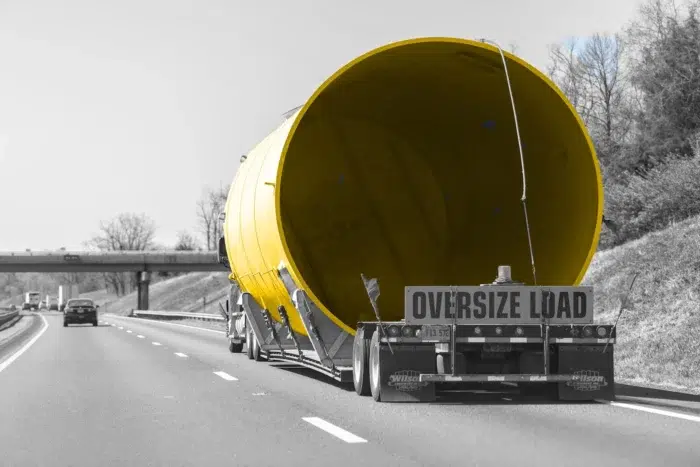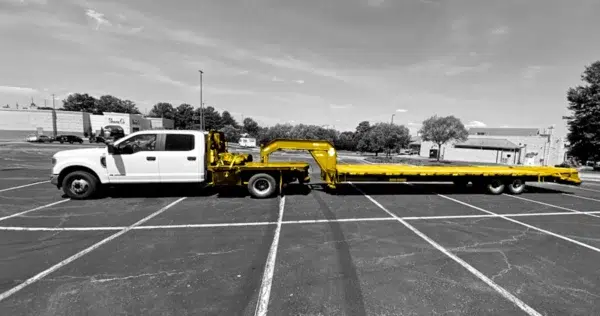
Navigating the Complexities of Over-Dimensional Shipping
July 18, 2024

In the world of logistics, over-dimensional shipping stands out as one of the most challenging and intricate aspects of freight transportation. This specialized type of shipping involves transporting cargo that exceeds standard legal size and weight limits, requiring meticulous planning, specialized equipment, and adherence to a myriad of regulations.
Here’s an in-depth look at over-dimensional shipping, why it’s important, and what it entails.


What is Over-Dimensional Shipping?
Over-dimensional shipping refers to the transport of cargo that surpasses the standard legal size and weight limits set by federal and state regulations. These limits can vary, but generally, a load is considered over-dimensional if it is more than:
- 8.5 feet wide
- 13.5’ – 14’ high (depending on the state/province)
- 48’ – 53’ long (depending on the configuration)
- 80,000lbs gross vehicle weight (although, specific axle limits are also critical)
Such loads require special handling, routing, and permits to ensure they can be transported safely and legally; and they should only be entrusted with highly experienced flatbed experts.
Common Types of Over-Dimensional Cargo
Over-dimensional shipping is typically required for large, bulky items that cannot be disassembled into smaller parts. Common examples include:
- Heavy machinery and industrial equipment
- Construction materials, such as steel beams and precast concrete
- Wind turbine blades and towers
- Large vehicles, including military equipment
- Oversized HVAC units and generators
Subscribe!
Subscribe to receive the latest articles, newsletters, whitepapers, and industry news directly to your inbox.
"*" indicates required fields
The Importance of Over-Dimensional Shipping
Over-dimensional shipping is crucial for various industries, enabling the transport of essential infrastructure and equipment that drive economic growth and development. Without the capability to move oversized loads, many large-scale construction projects, manufacturing operations, and energy developments would be impossible.

Key Considerations for Over-Dimensional Shipping
Regulatory Compliance: Transporting over-dimensional loads requires strict compliance with federal and state/provincial regulations. These regulations dictate the permissible dimensions and weight, the types of permits needed, and specific rules for securing and transporting such loads. Compliance ensures the safety of the transport, other road users, and the integrity of the cargo.
Permitting Process: Securing the necessary permits is a critical step in over-dimensional shipping. Each state/province has its own permitting requirements and processes, and obtaining these permits involves providing detailed information about the load, route, and transportation plan. Permits may also dictate specific travel times, such as avoiding rush hours or traveling only during daylight.
Route Planning: Effective route planning is essential for safely transporting over-dimensional loads. Routes must be carefully selected to avoid obstacles such as low bridges, narrow roads, and weight-restricted areas. Advanced route surveys and the use of specialized mapping tools help identify potential hazards and ensure a safe journey.
Specialized Equipment: Over-dimensional loads often require specialized equipment for safe and efficient transport. This equipment includes:
- Extendable Flatbeds: For loads that are longer than standard trailers.
- Double Drop Trailers: For loads that exceed height restrictions.
- Removable Gooseneck Trailers (RGN): For easy loading and unloading of heavy machinery.
- Multi-Axle Trailers: To distribute weight more evenly and comply with axle load limits.
Escort Vehicles: Many over-dimensional shipments require escort vehicles, or pilot cars, to accompany the load. These vehicles help navigate the route, provide warnings to other drivers, and assist with maneuvering through tight spaces. Depending on the size and route of the load, multiple escort vehicles may be necessary.
Safety Measures: Ensuring the safety of over-dimensional shipments involves:
- Proper Securing: Using appropriate tie-downs, chains, and binders to secure the load.
- Visibility: Adding flags, lights, and signage to alert other drivers of the oversized load.
- Communication: Maintaining clear communication between the driver, escort vehicles, and dispatchers.
Challenges in Over-Dimensional Shipping
Over-dimensional shipping presents several challenges, including:
Complex Regulations: Navigating the varying regulations across states/provinces can be time-consuming and complex.
Permit Delays: Obtaining the necessary permits can be a lengthy process, potentially causing delays.
Route Restrictions: Finding suitable routes that accommodate oversized loads requires careful planning and often involves detours.
Increased Costs: The need for specialized equipment, permits, and escort vehicles can significantly increase transportation costs.
Conclusion
Over-dimensional shipping is a critical component of modern logistics, enabling the transport of large, essential cargo that supports infrastructure and industry. While it involves complex planning, regulatory compliance, and specialized equipment, the successful execution of over-dimensional shipments ensures that vital projects and operations can proceed without interruption. Booking over-dimensional shipments with an expert is crucial because they have the specialized knowledge and experience to navigate complex regulations, secure necessary permits, and ensure safe, efficient transport Of your valuable cargo.
Contact Us to book your next over-dimensional shipment with TRAFFIX’ experienced flatbed team today!

